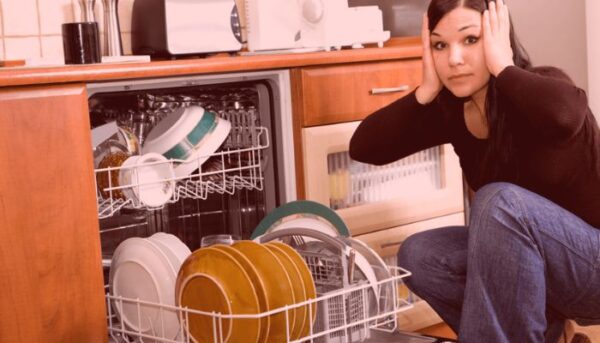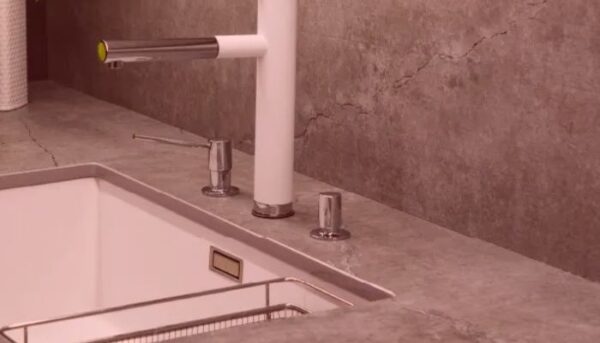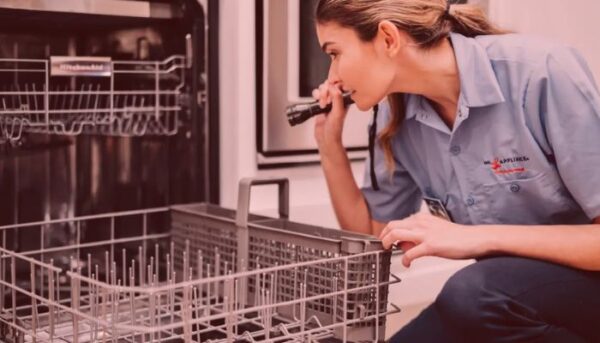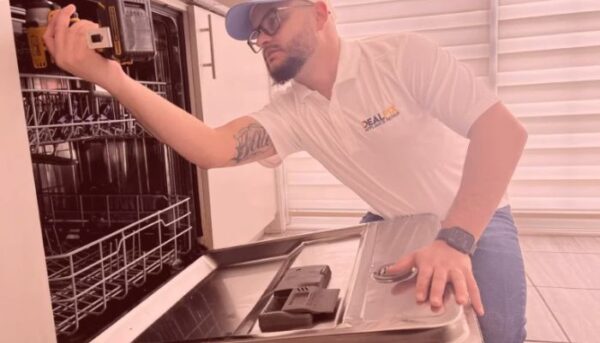Is your Whirlpool dishwasher not draining properly? I know how frustrating it can be to open your dishwasher and find standing water at the bottom. A drainage issue not only affects your washer’s performance but can also lead to unpleasant odors and even potential leaks.
Addressing this problem quickly is important. A clogged drain hose, a blocked filter, or a faulty drain pump could be the cause. In some cases, food debris or a plug in the sink drain can prevent water from flowing out properly. Ignoring these signs might mean more damage, requiring a technician or even a costly repair.
In this guide, I’ll walk you through the most common causes of a Whirlpool dishwasher not draining and how to solve them. Whether it’s cleaning the drain line, checking the impeller, or knowing when parts need to be replaced, I’ve got you covered!

Common Causes of Whirlpool Dishwasher Not Draining
Here are some of the most common reasons your Whirlpool dishwasher won’t drain and how to fix each issue properly.
Clogged Filters
Your Whirlpool dishwasher has a filter that catches food particles and debris to prevent them from clogging the drain line. Over time, if not cleaned regularly, the filter can get clogged, blocking water from draining properly.
Signs of a Clogged Filter:
- Water pooling at the bottom after a drain cycle
- Unpleasant odors coming from the dishwasher
- Dirty dishes after a full wash cycle
How to Clean the Filter:
- Remove the dishwasher‘s bottom rack to access the filter.
- Twist and lift the filter out.
- Rinse it under warm water to remove debris.
- Use a soft brush to scrub away any buildup.
- Reinstall the filter securely.
A clean filter ensures proper drainage and prevents future blockages.
Drain Hose Issues
The drain hose carries wastewater from your Whirlpool dishwasher to the sink drain or disposal. If it’s bent, clogged, or disconnected, water won’t flow out properly.
Common Drain Hose Problems:
- Kinks or bends restricting water flow
- Food particles or grease causing a blockage
- A loose connection leading to leaks
How to Inspect and Clean the Drain Hose:
- Turn off the dishwasher and unplug it.
- Locate the drain hose at the back of the washer.
- Check for visible kinks and straighten them if needed.
- If clogged, disconnect the drain hose and rinse it with warm water.
- Reattach securely to prevent leaks.
A clean and clear drain hose keeps your dishwasher drain running smoothly.
Garbage Disposal Problems
If your Whirlpool dishwasher is connected to a garbage disposal, a clog or an unremoved knockout plug could be blocking the drain line.
How to Check for Garbage Disposal Issues:
- Run the disposal to clear any food buildup.
- Check if the drain line is properly connected.
- If the disposal was recently installed, ensure the plug is removed.
How to Remove the Knockout Plug:
- Turn off the power to the disposal.
- Locate the side where the drain hose connects.
- Use a screwdriver and hammer to gently knock out the plug.
- Remove any plastic pieces and reconnect the drain hose.
A blocked disposal can prevent your dishwasher drain from working correctly.
Blocked Air Gap

The air gap is a small device near the sink drain that prevents dirty water from flowing back into your dishwasher. If it’s clogged, your dishwasher not draining issue could be due to trapped food particles.
How to Clean a Blocked Air Gap:
- Remove the air gap cover.
- Use a brush or a small pipe cleaner to remove debris.
- Rinse with warm water to ensure there’s no blockage.
A clear air gap helps maintain proper drain function.
Faulty Drain Pump
The drain pump pushes water out during the drain cycle. If it fails, your dishwasher may stop draining completely.
Signs of a Faulty Drain Pump:
- Strange humming sounds but no water movement
- Standing water even after multiple cycles
- Visible damage to the impeller
How to Replace the Drain Pump:
- Unplug the dishwasher and turn off the water supply.
- Remove the bottom panel and locate the drain pump.
- Disconnect wires and hoses attached to the drain pump.
- Install a new pump and reconnect everything securely.
If the pump is beyond DIY repair, a technician may be needed.
Incomplete Wash Cycle
If your dishwasher cycle is interrupted, it may not finish draining. This can happen due to a power outage or accidentally opening the door mid-cycle.
How to Restart the Cycle:
- Close the dishwasher door securely.
- Press the reset button (if available) or start a new cycle.
- Let the cycle run completely to see if the drain works properly.
A quick reset might solve the issue.
Electrical or Mechanical Failures
If none of the above fixes work, your Whirlpool dishwasher might have an electrical or sensor issue.
How to Diagnose Electrical Problems:
- Check if the control panel responds properly.
- Look for error codes on the display.
- Ensure there are no blown fuses or tripped breakers.
A faulty sensor or circuit might require a service technician to fix.
Preventive Maintenance Tips

To keep your Whirlpool dishwasher draining properly, regular maintenance is key. A few simple steps can help prevent clogs, blockages, and costly repairs.
Regularly Clean Filters and Drain Components
The filter traps food particles and prevents them from blocking the drain line. If left uncleaned, it can cause drainage issues. I make it a habit to clean the filter once a month by removing it and rinsing it under warm water. The drain pump area should also be checked for any trapped debris.
Avoid Overloading with Food Debris
It’s easy to assume the dishwasher will handle all leftover food, but too much can lead to a blockage in the drain hose or disposal. I always scrape off large food particles before loading the dishes. This small step prevents clogs and ensures smooth water flow through the drain cycle.
Perform Routine Inspections of Hoses and Connections
Every few months, I check the drain hose for kinks, cracks, or leaks. A blocked drain hose or a loose connection can cause water to back up. If needed, I disconnect the drain hose to flush out any buildup, ensuring water flows properly to the sink drain.
Use Dishwasher-Safe Cleaning Products
Using the right cleaning products helps prevent buildup in the drain pump, valve, and impeller. I avoid harsh chemicals that can damage parts over time. Instead, I run a cleaning cycle with vinegar or a dishwasher-safe cleaner once a month to keep everything fresh.
When to Call a Professional?

Sometimes, no matter how much I troubleshoot my Whirlpool dishwasher, it still won’t drain properly. If I’ve already cleaned the filter, checked the drain hose, and ensured there’s no blockage, but water is still pooling at the bottom, it might be time to call a technician.
One major sign that DIY fixes aren’t enough is when the dishwasher not draining issue keeps happening after multiple attempts to solve it. A persistent drain problem could mean there’s an issue with the drain pump, valve, or even the impeller, which might need to be replaced. If I hear unusual noises or the dishwasher drain isn’t working despite a full cycle, a professional can diagnose and service the faulty part.
Electrical problems are another red flag. If the control panel is unresponsive, error codes appear, or the drain cycle doesn’t start, there could be a wiring issue or a sensor failure. Since dealing with electrical components can be risky, I prefer to leave this to a trained technician.
Lastly, if there’s a leak, a cracked drain hose, or a worn-out drain pump, I don’t take chances. Replacing these parts requires expertise, and incorrect installation can cause more damage. A professional can replace the drain pump, check for hidden issues, and ensure my Whirlpool dishwasher is running smoothly.
Conclusion
A Whirlpool dishwasher that won’t drain is frustrating, but in most cases, the issue is easy to fix with the right approach.
Regular maintenance, like cleaning the filter, inspecting the drain hose, and ensuring the garbage disposal is clear, can prevent common drainage problems. A clog, blockage, or bent drain hose can often be fixed with simple troubleshooting.
If the drain pump, valve, or impeller is damaged, a replacement may be necessary. Electrical issues, recurring drain problems, or persistent leaks may require a technician to diagnose and service the dishwasher.
By staying proactive with maintenance and knowing when to seek professional help, I can keep my Whirlpool dishwasher working efficiently and avoid unnecessary repairs.
FAQs
Why Does My Whirlpool Dishwasher Leave Water in the Bottom?
Your Whirlpool dishwasher may not be draining due to a clogged filter, drain hose, or air gap. Food debris can block these parts, preventing proper drainage. Additionally, a faulty drain pump, valve, or issues with the garbage disposal can also cause water to remain after a cycle.
How Do I Force My Dishwasher to Drain?
To manually drain your Whirlpool dishwasher, press and hold the Cancel or Drain button for three seconds. This activates the drain pump to remove standing water. If that doesn’t work, check the filter, drain hose, and air gap for clogs or blockages, then clean them as needed.
How Do I Reset My Whirlpool Dishwasher to Fix Draining Issues?
To reset, unplug your Whirlpool dishwasher for 5-10 minutes. Another method is pressing “Heated Dry” and “Normal” twice in succession. If needed, turn off the circuit breaker for 10 minutes before restoring power. A reset can help fix drainage issues caused by software glitches or sensor malfunctions.
How Do I Unclog My Whirlpool Dishwasher’s Drain Hose?
First, disconnect the drain hose from the sink drain or garbage disposal. Inspect it for clogs, kinks, or blockages. Flush water through the hose or use a wire to remove debris. Once clean, securely reattach it and test if the dishwasher drain works properly.
Can a Clogged Garbage Disposal Affect My Dishwasher’s Drainage?
Yes, a clogged garbage disposal can block the dishwasher drain because they share a drain line. If the disposal is blocked, water may back up into the dishwasher. Running the disposal and clearing any plug or blockage can help restore proper drainage.
